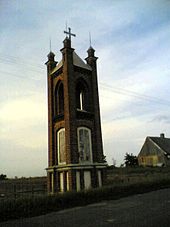Trzciano
| Trzciano | ||
|---|---|---|

|
|
|
| Basic data | ||
| State : | Poland | |
| Voivodeship : | Pomerania | |
| Powiat : | Kwidzyn | |
| Gmina : | Ryjewo | |
| Area : | 11.41 km² | |
| Geographic location : | 53 ° 48 ' N , 19 ° 4' E | |
| Residents : | 440 ( 2005 ) | |
| Postal code : | 82-412 (Ryjewo) | |
| Telephone code : | (+48) 55 | |
| License plate : | GKW | |
| Economy and Transport | ||
| Street : | Kwidzyn - Ryjewo | |
| Next international airport : | Danzig | |
Trzciano (pronunciation: [tʂʨanɔ] , German Honigfelde or Königfelde ) is a village in the rural community Ryjewo (German: Rehhof ) in the district of Kwidzyn (German: Marienwerder ) in the Pomeranian Voivodeship in northern Poland . It is about ten kilometers northeast of Kwidzyn and has 440 inhabitants.
history
Trzciano is a foundation of the Teutonic Order from the middle of the 14th century. Between 1327 and 1366 the Germans created many new villages and encouraged Polish peasants to live under their rule by giving them noble names. The first written mention of Trzciano can be found in medieval books in which it is mentioned as a honey field . Later the name was mistakenly transcribed as Königfelde .
At the end of the Thirteen Years' War Trzciano became part of the Polish province of Prussia royal share (Polish: Prusy Królewskie ) in 1466 . At the beginning of the 16th century it came into the possession of the Brandt family.
During the Thirty Years' War and the subsequent Swedish occupation of the Vistula Delta (beginning 1626) - known as the Swedish Flood - Pomerania became the site of many military conflicts between Polish and Swedish troops. On June 26, 1629 the Battle of Trzciano ended with the victory of the Polish hetman Stanisław Koniecpolski over Gustav Adolf . This failure ended the Swedish advance south and forced the Swedes to give up Marienwerder and retreat into the Vistula Delta. A small shrine was built to commemorate Koniecpolski's victory, there is also a memorial stone.
The Battle of Trzciano is referred to in Polish chronicles as Bitwa pod Trzcianką , "Trzcianka" was probably the name of the place used during the 17th and 18th centuries. This name developed from the Polish word trzcina , which can be translated as pipe . The name of the village later changed to “Trzciana” and, in the 19th century, to Trzciano, its current form.
Due to the first partition , Poland lost Trzciano in 1772 together with the rest of the then German-speaking Polish province of Prussia to the newly created province of West Prussia of the Kingdom of Prussia .
After Poland's independence was restored in 1918, Trzciano was part of the German exclave of East Prussia . Shortly after the Second World War , Trzciano became Polish again in 1945.
Legend
According to a local legend, Gustav Adolph, the defeated King of Sweden, dropped his scepter in desperation while fleeing over one of the lakes of Trzciano , symbolically ending his reign. According to legend, the scepter lies on the bottom of the lake to this day.
Daughter of the place
- Inge Mager (* 1940), church historian


